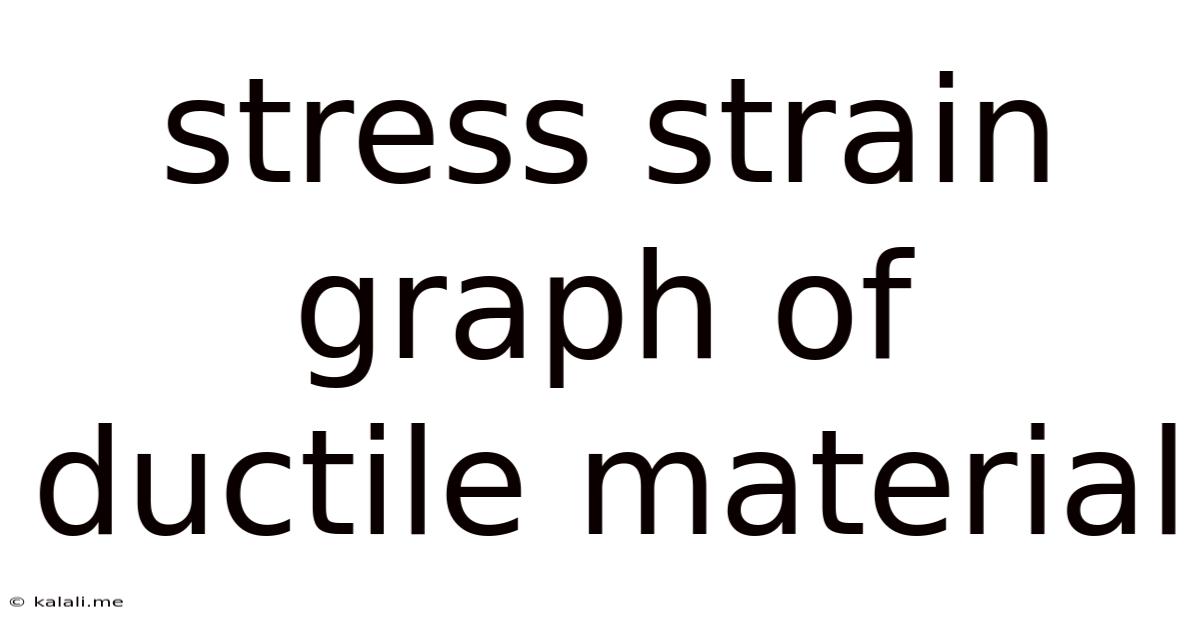Stress Strain Graph Of Ductile Material
Kalali
Jun 11, 2025 · 3 min read

Table of Contents
Understanding the Stress-Strain Graph of Ductile Materials
The stress-strain graph, also known as an engineering stress-strain curve, is a fundamental tool in materials science and engineering. It provides crucial information about a material's mechanical behavior under load, particularly its strength, ductility, and toughness. This article focuses on interpreting the stress-strain graph of ductile materials, detailing its key features and their significance. Understanding this graph is essential for selecting appropriate materials for various engineering applications.
What is a Ductile Material?
Ductile materials are those that can undergo significant plastic deformation before fracture. This means they can be stretched or bent considerably without breaking. Examples include most metals like mild steel, aluminum, and copper. This contrasts with brittle materials, which fracture with little to no plastic deformation.
Key Features of the Stress-Strain Curve for Ductile Materials
The typical stress-strain curve for a ductile material displays several distinct regions:
1. Elastic Region:
- This initial, linear portion of the curve obeys Hooke's Law, where stress is directly proportional to strain. The slope of this linear region represents the Young's modulus (E), a measure of the material's stiffness or resistance to elastic deformation. The material returns to its original shape upon unloading in this region.
- Proportional Limit: The point up to which Hooke's Law holds true. Beyond this point, the relationship between stress and strain becomes non-linear.
2. Yield Point:
- Marks the transition from elastic to plastic deformation. Beyond this point, permanent deformation occurs, and the material will not return to its original shape upon unloading.
- Yield Strength (σy): The stress at the yield point. This is a crucial parameter in design, as it indicates the stress level at which permanent deformation begins. Several methods exist to determine the yield strength, including the 0.2% offset method.
3. Plastic Region:
- Characterized by significant plastic deformation. The material undergoes permanent changes in shape in this region.
- Strain Hardening (Work Hardening): As plastic deformation progresses, the material becomes stronger and harder, requiring increasing stress to cause further deformation. This is reflected in the upward slope of the curve in this region.
- Ultimate Tensile Strength (UTS): The maximum stress the material can withstand before necking begins. This is a key indicator of the material's strength.
4. Necking:
- A localized reduction in cross-sectional area. This occurs after the UTS is reached, leading to a decrease in the engineering stress despite continued plastic deformation. The true stress continues to increase, however, until fracture.
5. Fracture Point:
- The point at which the material breaks. The stress at fracture is lower than the UTS due to the necking phenomenon. The strain at fracture is a measure of the material's ductility.
Interpreting the Graph for Material Selection:
The stress-strain curve provides invaluable information for material selection in engineering design. Key properties that can be determined include:
- Yield Strength: Essential for ensuring components don't undergo permanent deformation under service loads.
- Ultimate Tensile Strength: Indicates the maximum load-carrying capacity of the material.
- Ductility: Measured by elongation and reduction in area at fracture, indicating the material's formability and ability to absorb energy before failure. Higher ductility implies greater toughness.
- Young's Modulus: Indicates the stiffness of the material.
- Toughness: Represents the ability of a material to absorb energy before fracture. It can be estimated from the area under the stress-strain curve.
Understanding the stress-strain curve is paramount for engineers to select materials that meet the specific requirements of a given application. The curve provides a concise yet comprehensive picture of a material's mechanical properties, allowing for informed decision-making in design and manufacturing.
Latest Posts
Latest Posts
-
How Many Ears Of Corn To A Bushel
Jul 01, 2025
-
How Many Months Are In A Quarter
Jul 01, 2025
-
How Much Does A 12 Pack Of Pop Weigh
Jul 01, 2025
-
How Many Shots In A Half Gallon
Jul 01, 2025
-
Someone Once Told Me The World Was Macaroni
Jul 01, 2025
Related Post
Thank you for visiting our website which covers about Stress Strain Graph Of Ductile Material . We hope the information provided has been useful to you. Feel free to contact us if you have any questions or need further assistance. See you next time and don't miss to bookmark.